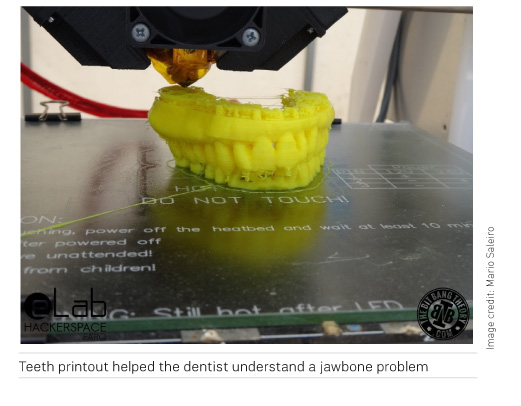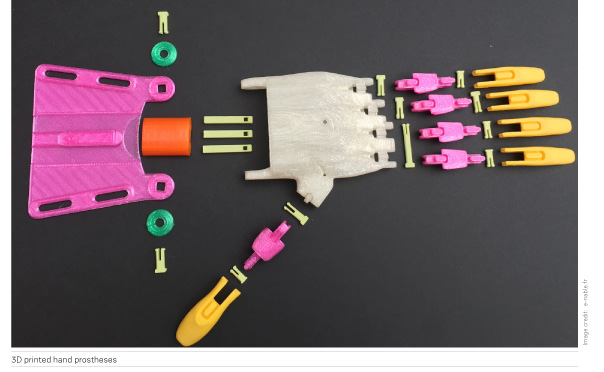HealthManagement, Volume 17 - Issue 3, 2017
An Opportunity for the Future
3D makerspaces could help hospitals to enter the world of 3D technology without needing a big budget and employing expensive specialists.
We have all heard about 3D printing, and the first hospitals have already begun to integrate this technology into their everyday business. Prostheses made of plastic compound materials are being tailor made. CT scans are printed out in 3D for educational purposes, and in preparation for complicated operations meanwhile even the first organs such as an entire ear can be printed.
Some of the applications of 3D printing are still in the beta phase. The required hardware is very expensive and needs skilled personnel. However, other applications are widely accepted and used and the needed hardware is affordable.
Nevertheless, to make use of this technology we need to invest in 3D printing know-how and hardware. We do not even know the exact use and for which cases, so we need to have consultancy from a 3D expert upfront. This is where so called “makerspaces“ could play an important role for hospitals.
What is a Makerspace?
A makerspace is a unit where modern technology like 3D printing, scanning and drawing, computer numerical controlled (CNC) milling and modern robotics meet skilled people. Some makerspaces are owned by universities, some by companies and others are privately owned or non-commercial. They are already spread around the globe and every big town has at least one. Here we have to differentiate between commercial and non-commercial makerspaces.
I n contrast to commercial ones, a non-commercial makerspace would not be able to commercialise their services or handle a more intense partnership. The basic business model works like this: as a private person you pay a monthly fee to bring your idea, your project to life with the help of skilled personnel. As a company the costs depend on many factors, but still bear no comparison to hospital in-house solutions. Sometimes engineers, sometimes so called “makers“ help you design and materialise what you need. Companies also make use of these makerspaces, often also called “hackerspaces“. Today, projects and new products have to be brought to market instantly. Where only five years ago we needed two to three years from a first prototype to a product that is ready to enter the market, we are now able to do this within months. We call this rapid prototyping.
You might also like:3D Printing: An Interdisciplinary Lab
Some companies have their own makerspaces in house, mostly called industry labs. For example, IBM hosts its own industry lab in t heir recently opened Watson Internet of Things centre in Munich, which is one of the most innovative spaces in this area (see photo on next page). They brought together engineers and technicians from different areas of expertise to help their clients win the race against time in today´s product development business.
From my perspective, there should be a close partnership between hospitals and makerspaces as well. There are many applications where makerspaces could help a hospital to enter the world of this technology without the need for a big budget and employing expensive specialists. Makerspaces are skilled, fast and can produce unique items for reasonable prices.
The Praxis
Let me give you an example of what I am talking about: At last year`s “makerfaire“ in Lisbon, Ricardo Perreira (ricardopereira.org) from Porto asked me to do a 3D scan of a child‘s forearm. The five year old boy lost his left hand in an accident and needed a prosthesis. Ricardo did a plaster cast from the forearm and I handed the data from its 3D scan back to him. Having this data available, he could adapt a 3D model of a prosthesis for the child and print it out the next day. Within two days of this exhibition the child had a tailor-made prosthesis for his forearm, leaving his father with tears in his eyes. There are lots of different 3D models of prostheses already available for download on the internet, which only need adaptation. Mario Saleiro (sandworx.com) from the University of Faro obtained the CT scan data from a scan of his head, converted this data and printed out his entire set of teeth. His dentist then used this print to better understand his jawbone problem.
So the data from 3D scans can be more or less directly used to print parts from it. This can also be done in translucent materials.


Can These Parts Break?
A question often asked is how strong can a 3D printed part be. This depends on the quality of the print, its material and on the type of 3D printer used. There are plastic materials like ABS , PLA or PETG for example. Their Rockwell hardness and flexibility is all different and it is hard to compare it to an injection moulded part. The main difference is that usually 3D printed parts are not printed in full material. They normally have a structure inside like a honeycomb, which makes them very lightweight and strong.
There are also compound materials: combinations of plastic and reinforcing materials such as carbon fibre, for example. With these compounds, extraordinary strength can be achieved. A lot depends on layer bonding and thus arranging layers in t he correct direction of t he main forces. Liquid resins and powders are also available with different properties. A perfect choice of the right material is key.
What Types of 3D Printers are Usually Found in Makerspaces ?
The four main types of 3D printers we can find in makerspaces are:
- Fused deposition modelling (FDM) printers, which melt a
plastic wire to build layer upon layer
- Stereolithography (SLA) printers, which cure liquid resin to
build the layers
- Selective Layer Sintering (SLS) printers that use a powder
to build layers, and
- Syringe printers, which dose a liquid-type material that
hardens in free air or in an oven

For prostheses we usually use FDM printers as the end products have the most strength, though having typically visible layers. For models used for education or research background one would use SLA printers with transparent resin, which results in a nearly transparent result, though not as strong as FDM.
S LS printers are the most expensive. They can transform powder containing different materials into extremely strong parts. The cheaper printers can only melt materials with a lower melting point, leaving a slightly rough surface without any visible layer, whereas the best ones can even use powder-containing metals.
Conclusion
Not only will doctors love these new opportunities, technical maintenance teams will do so too. Broken mechanical parts that are hard to get or take a very long time to be delivered or those which are extremely expensive can be reproduced with the help of a makerspace. Small problem solvers can be designed to help improve everyday business. I n many parts of the world prostheses are very expensive for the patient, and when it comes to children, these technical aids have to be replaced several times during their childhood. In makerspaces the costs for such tasks like scanning and printing are in the range of tens or hundreds, but not thousands of euros or dollars.
Private individuals are beginning to discover these spaces for themselves, but it would be much more efficient and professional if a surgeon could give guidelines to the architect of a plastic hand.
T he main potential of 3D printing lies in the vast variety of things you can do with it. Go forward, explore them and create a win-win-win situation for your hospital, makerspaces and, not to forget, in the end for the patients themselves.
Key Points
- Makerspaces are physical units where modern technology like
3D printing, scanning and drawing, computer numerical controlled (CNC) milling
and modern robotics meet skilled people
- Makerspaces can be commercial or non-commerical, and most
large towns have one
- Makerspaces can enable hospitals to print in 3D without
needing a big budget or expensive specialists
- Practical examples are given of use in healthcare
- Materials used and printer types are explained



